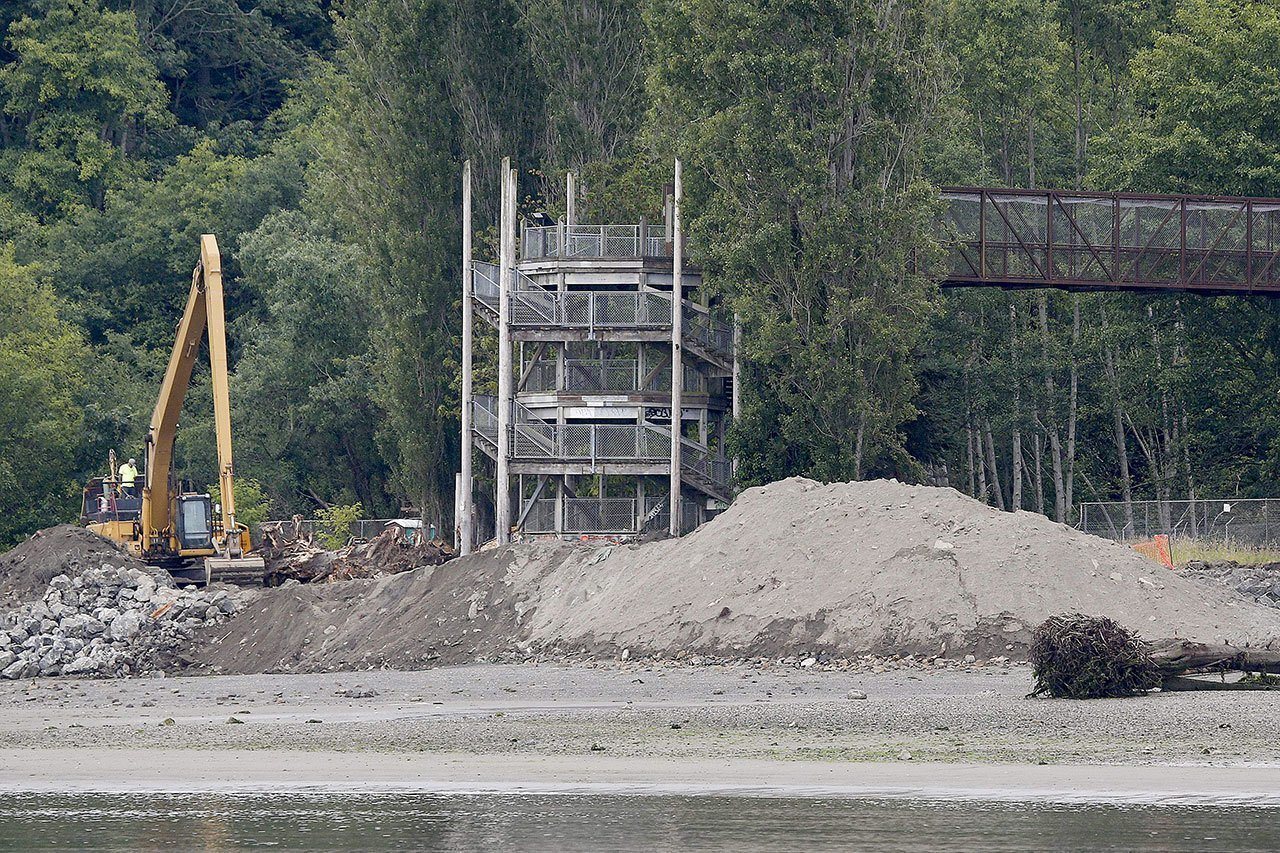EVERETT — People and fish could soon be enjoying a better beach at Howarth Park.
Contractors have been busy for the past couple of weeks busting up a concrete and rock wall at the city park. They’re also dumping tons of sand along the shoreline. It’s part of a habitat-restoration project undertaken by Snohomish County to boost the populations of small fish that larger marine animals rely on for food.
Humans also might like what they find when shoreline access reopens, possibly later this summer.
“When you go down to Howarth Park, you’re not going to see this big rock wall,” said Kathleen Herrmann, a senior planner with Snohomish County Public Works. “We’re also benefiting people by improving the beach area so they’ll have more room to walk.”
The project coincides with the city’s ongoing closure of the Howarth Park pedestrian bridge over the railroad tracks.
For the county project that began this month, contractors have been barging out sand to rebuild the park beach and three other spots between Everett and Mukilteo. Known as beach nourishment, the technique is similar to rebuilding East Coast shorelines after storms, Herrmann said.
The county’s goal was to increase survival rates for fish such as surf smelt, sand lance and herring. Known as forage fish, they are preyed upon by salmon, seals and birds.
While other habitat projects have aimed to give salmon more room in the Snohomish River estuary and local creeks, “This is the first one that deals with the nearshore,” said Dave Lucas, a project engineer with the county’s Public Works Department.
Forage fish need sand and gravel to spawn. Young salmon also use the shallow coastal waters to avoid predators.
Shoreline development has disrupted those areas. It’s had an effect up the food chain.
The county project was supposed to get under way last year, but the initial bids came back higher than expected, Herrmann said. This spring, the county awarded the job to Redside Construction of Bainbridge Island for just over $1.2 million. State and federal grants are covering most of the cost.
Crews have headed out as early as 3 a.m. to take advantage of high tides. They ship the sand out in barge loads of 1,500 tons at a time, said Bob Hillmann, a project coordinator with Everett Parks and Recreation. The barge can carry more sand, but would sit too low in the water and wouldn’t be able to get as close to the beach.
The material comes from the spoils dredged from the Snohomish River to keep it navigable. Some 200,000 yards of it is stockpiled at city property along the river.
Once placed on the beach, Puget Sound currents are expected to also carry the sand to other areas.
“We’ll be looking to see where the sediment is moving throughout the whole four-mile area,” Herrmann said.
Under natural conditions, the coastal bluffs above the shore would replenish the beach through erosion. The railroad tracks along the shore in Everett, Mukilteo and nearby areas pose a barrier that have mostly blocked that from happening for more than a century.
In addition to Howarth, crews are dumping sand around the outlets for Glenwood Creek, Narbeck Creek and at Powder Mill Gulch.
They’re also using heavy equipment to break apart a rock revetment and concrete bulkhead at Howarth. They’re reburying it closer to the stair tower to project it from the water.
“When you walk out at high tide, the beach area will be about four times bigger than it was before,” Herrmann said.
The project is expected to finish up some time in July with plantings on the beach and new interpretive signs, Herrmann said.
Preparations for the beach nourishment have been underway for at least five years.
Volunteers from the Snohomish County Beach Watchers and the county’s Marine Resources Committee have been conducting tests to estimate forage fish populations. The work involves sifting through beach sand for fish eggs, some of which measure just a few millimeters wide.
The data collected so far should provide a baseline to determine what effect the beach nourishment has in future years.
Howarth Park is expected to stay closed for bridge repairs even after the county project wraps up.
The city closed the beach access at Howarth in May 2015 after a bridge inspection turned up rust and corrosion on steel beams in the span that provided people a safe route from the bluff to the beach over the railroad tracks.
Last month, city officials estimated that the closure would last through July, but that time line is uncertain. The contractor is awaiting BNSF Railway’s final approval of a contract and insurance documents that would allow construction to start, city parks director Lori Cummings said.
“We do not have a construction start date, but hope that will be in the very near future,” Cummings said.
Bridge repairs are estimated to cost about $400,000.
The original bridge, wall and stair tower were built in 1972. A new bridge was built in 1987.
Noah Haglund: 425-339-3465; nhaglund@heraldnet.com. Twitter: @NWhaglund
Talk to us
> Give us your news tips.
> Send us a letter to the editor.
> More Herald contact information.

























